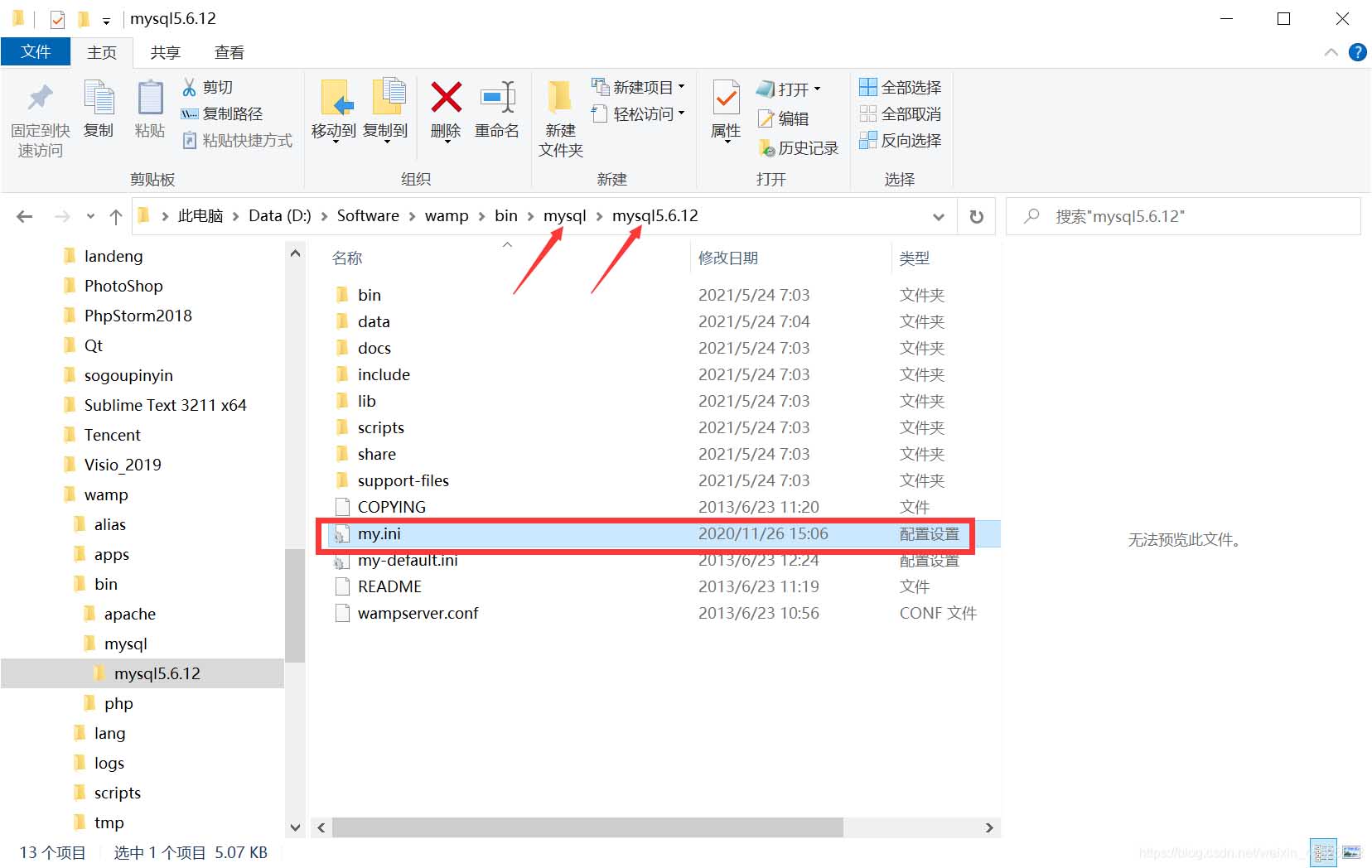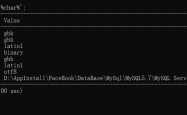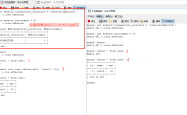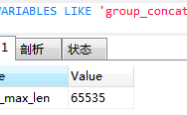MySQL配置文件my.ini的使用解读
吾爱主题
阅读:259
2022-12-27 20:45:00
评论:0
my.ini 是啥玩意?
my.ini是MySQL数据库中使用的配置文件,修改这个文件可以达到更新配置的目的。
my.ini 在哪放着呢?
my.ini存放在MySql安装的根目录,如图所示:(我比较懒,用的WAMP,大家找自己的安装目录即可)

my.ini的配置内容介绍
其实大体可以分为两部分:客户端的参数、服务器参数。
其中服务器参数里还包括 InnoDB存储引擎参数。
客户端的参数
下面显示的是客户端的参数,[client]和[mysql]都是客户端,下面是参数简介:
-
port参数表示的是MySQL数据库的端口,默认的端口是3306,如果你需要更改端口号的话,就可以通过在这里修改。 -
default-character-set参数是客户端默认的字符集,如果你希望它支持中文,可以设置成gbk或者utf8。 - 这里还有一个
password参数,在这里设置了password参数的值就可以在登陆时不用输入密码直接进入
| 1 2 3 4 5 6 7 8 9 10 11 12 13 14 15 16 | # CLIENT SECTION # ---------------------------------------------------------------------- # # The following options will be read by MySQL client applications. # Note that only client applications shipped by MySQL are guaranteed # to read this section . If you want your own MySQL client program to # honor these values , you need to specify it as an option during the # MySQL client library initialization. # [client] port=3306 [mysql] default - character - set =gb2312 |
服务器断参数
以下是参数的介绍:
-
port参数也是表示数据库的端口。 -
basedir参数表示MySQL的安装路径。 -
datadir参数表示MySQL数据文件的存储位置,也是数据库表的存放位置。 -
default-character-set参数表示默认的字符集,这个字符集是服务器端的。 -
default-storage-engine参数默认的存储引擎。 - 这里有两个引擎 MyISAM 和 InnoDB ,用什么看你需求,详细介绍可以参考下面这篇文章:http://www.tuohang.net/article/270995.htm
-
sql-mode参数表示SQL模式的参数,通过这个参数可以设置检验SQL语句的严格程度。 -
max_connections参数表示允许同时访问MySQL服务器的最大连接数,其中一个连接是保留的,留给管理员专用的。 -
query_cache_size参数表示查询时的缓存大小,缓存中可以存储以前通过select语句查询过的信息,再次查询时就可以直接从缓存中拿出信息。 -
table_cache参数表示所有进程打开表的总数。 -
tmp_table_size参数表示内存中临时表的总数。 -
thread_cache_size参数表示保留客户端线程的缓存。 -
myisam_max_sort_file_size参数表示MySQL重建索引时所允许的最大临时文件的大小。 -
myisam_sort_buffer_size参数表示重建索引时的缓存大小。 -
key_buffer_size参数表示关键词的缓存大小。 -
read_buffer_size参数表示MyISAM表全表扫描的缓存大小。 -
read_rnd_buffer_size参数表示将排序好的数据存入该缓存中。 -
sort_buffer_size参数表示用于排序的缓存大小
| 1 2 3 4 5 6 7 8 9 10 11 12 13 14 15 16 17 18 19 20 21 22 23 24 25 26 27 28 29 30 31 32 33 34 35 36 37 38 39 40 41 42 43 44 45 46 47 48 49 50 51 52 53 54 55 56 57 58 59 60 61 62 63 64 65 66 67 68 69 70 71 72 73 74 75 76 77 78 79 80 81 82 83 84 85 86 87 88 89 90 91 92 93 94 95 96 97 98 99 | # SERVER SECTION # ---------------------------------------------------------------------- # # The following options will be read by the MySQL Server. Make sure that # you have installed the server correctly (see above) so it reads this # file. # [mysqld] # The TCP/IP Port the MySQL Server will listen on port=3306 #Path to installation directory. All paths are usually resolved relative to this. basedir= "E:/Java/Mysql/" #Path to the database root datadir= "C:/ProgramData/MySQL/MySQL Server 5.5/Data/" # The default character set that will be used when a new schema or table is # created and no character set is defined character - set -server=gb2312 # The default storage engine that will be used when create new tables when default -storage-engine=INNODB # Set the SQL mode to strict sql-mode= "STRICT_TRANS_TABLES,NO_AUTO_CREATE_USER,NO_ENGINE_SUBSTITUTION" # The maximum amount of concurrent sessions the MySQL server will # allow. One of these connections will be reserved for a user with # SUPER privileges to allow the administrator to login even if the # connection limit has been reached. max_connections=100 # Query cache is used to cache SELECT results and later return them # without actual executing the same query once again. Having the query # cache enabled may result in significant speed improvements, if your # have a lot of identical queries and rarely changing tables. See the # "Qcache_lowmem_prunes" status variable to check if the current value # is high enough for your load . # Note: In case your tables change very often or if your queries are # textually different every time , the query cache may result in a # slowdown instead of a performance improvement. query_cache_size=0 # The number of open tables for all threads. Increasing this value # increases the number of file descriptors that mysqld requires. # Therefore you have to make sure to set the amount of open files # allowed to at least 4096 in the variable "open-files-limit" in # section [mysqld_safe] table_cache=256 # Maximum size for internal ( in -memory) temporary tables. If a table # grows larger than this value, it is automatically converted to disk # based table This limitation is for a single table . There can be many # of them. tmp_table_size=35M # How many threads we should keep in a cache for reuse. When a client # disconnects, the client 's threads are put in the cache if there aren' t # more than thread_cache_size threads from before. This greatly reduces # the amount of thread creations needed if you have a lot of new # connections. (Normally this doesn 't give a notable performance # improvement if you have a good thread implementation.) thread_cache_size=8 #*** MyISAM Specific options # The maximum size of the temporary file MySQL is allowed to use while # recreating the index (during REPAIR, ALTER TABLE or LOAD DATA INFILE. # If the file-size would be bigger than this, the index will be created # through the key cache (which is slower). myisam_max_sort_file_size=100G # If the temporary file used for fast index creation would be bigger # than using the key cache by the amount specified here, then prefer the # key cache method. This is mainly used to force long character keys in # large tables to use the slower key cache method to create the index. myisam_sort_buffer_size=69M # Size of the Key Buffer, used to cache index blocks for MyISAM tables. # Do not set it larger than 30% of your available memory, as some memory # is also required by the OS to cache rows. Even if you' re not using # MyISAM tables, you should still set it to 8-64M as it will also be # used for internal temporary disk tables. key_buffer_size=55M # Size of the buffer used for doing full table scans of MyISAM tables. # Allocated per thread, if a full scan is needed. read_buffer_size=64K read_rnd_buffer_size=256K # This buffer is allocated when MySQL needs to rebuild the index in # REPAIR, OPTIMZE, ALTER table statements as well as in LOAD DATA INFILE # into an empty table . It is allocated per thread so be careful with # large settings. sort_buffer_size=256K |
InnoDB存储引擎使用的参数:
以下是参数的简介:
-
innodb_additional_mem_pool_size参数表示附加的内存池,用来存储InnoDB表的内容。 -
innodb_flush_log_at_trx_commit参数是设置提交日志的时机,若设置为1,InnoDB会在每次提交后将事务日志写到磁盘上。 -
innodb_log_buffer_size参数表示用来存储日志数据的缓存区的大小。 -
innodb_buffer_pool_size参数表示缓存的大小,InnoDB使用一个缓冲池类保存索引和原始数据。 -
innodb_log_file_size参数表示日志文件的大小。 -
innodb_thread_concurrency参数表示在InnoDB存储引擎允许的线程最大数。
| 1 2 3 4 5 6 7 8 9 10 11 12 13 14 15 16 17 18 19 20 21 22 23 24 25 26 27 28 29 30 31 32 33 34 35 36 37 38 39 40 41 42 43 44 45 46 47 48 49 50 51 52 | #*** INNODB Specific options *** # Use this option if you have a MySQL server with InnoDB support enabled # but you do not plan to use it. This will save memory and disk space # and speed up some things. #skip-innodb # Additional memory pool that is used by InnoDB to store metadata # information. If InnoDB requires more memory for this purpose it will # start to allocate it from the OS. As this is fast enough on most # recent operating systems, you normally do not need to change this # value. SHOW INNODB STATUS will display the current amount used. innodb_additional_mem_pool_size=3M # If set to 1, InnoDB will flush (fsync) the transaction logs to the # disk at each commit , which offers full ACID behavior. If you are # willing to compromise this safety, and you are running small # transactions, you may set this to 0 or 2 to reduce disk I/O to the # logs. Value 0 means that the log is only written to the log file and # the log file flushed to disk approximately once per second . Value 2 # means the log is written to the log file at each commit , but the log # file is only flushed to disk approximately once per second . innodb_flush_log_at_trx_commit=1 # The size of the buffer InnoDB uses for buffering log data. As soon as # it is full , InnoDB will have to flush it to disk. As it is flushed # once per second anyway, it does not make sense to have it very large # (even with long transactions). innodb_log_buffer_size=2M # InnoDB, unlike MyISAM, uses a buffer pool to cache both indexes and # row data. The bigger you set this the less disk I/O is needed to # access data in tables. On a dedicated database server you may set this # parameter up to 80% of the machine physical memory size . Do not set it # too large, though, because competition of the physical memory may # cause paging in the operating system. Note that on 32bit systems you # might be limited to 2-3.5G of user level memory per process, so do not # set it too high. innodb_buffer_pool_size=107M # Size of each log file in a log group . You should set the combined size # of log files to about 25%-100% of your buffer pool size to avoid # unneeded buffer pool flush activity on log file overwrite. However, # note that a larger logfile size will increase the time needed for the # recovery process. innodb_log_file_size=54M # Number of threads allowed inside the InnoDB kernel. The optimal value # depends highly on the application, hardware as well as the OS # scheduler properties. A too high value may lead to thread thrashing. innodb_thread_concurrency=18 |
中文翻译版 my.ini
?| 1 2 3 4 5 6 7 8 9 10 11 12 13 14 15 16 17 18 19 20 21 22 23 24 25 26 27 28 29 30 31 32 33 34 35 36 37 38 39 40 41 42 43 44 45 46 47 48 49 50 51 52 53 54 55 56 57 58 59 60 61 62 63 64 65 66 67 68 69 70 71 72 73 74 75 76 77 78 79 80 81 82 83 84 85 86 87 88 89 90 91 92 93 94 95 96 97 98 99 100 101 102 103 104 105 106 107 108 109 110 111 112 113 114 115 116 117 118 119 120 121 122 123 124 125 126 127 | [client] port=3306 [mysql] default - character - set =gbk [mysqld] port = 3306 socket = /tmp/mysql.sock # 设置mysql的安装目录 basedir=F:\\Hzq Soft\\MySql Server 51GA # 设置mysql数据库的数据的存放目录,必须是data,或者是\\xxx-data datadir=F:\\Hzq Soft\\MySql Server 51GA\\data #innodb_log_arch_dir 默认datadir #innodb_log_group_home_dir 默认datadir # 设置mysql服务器的字符集,默认编码 default - character - set =utf8 #连接数的操作系统监听队列数量,如果经常出现“拒绝连接”错误可适当增加此值 back_log = 50 #不使用接听TCP / IP端口方法,mysqld通过命名管道连接 #skip-networking # 最大连接数量 max_connections = 90 #打开表的线程数量限定,最大4096,除非用mysqld_safe打开限制 table_open_cache = 2048 #MySql 服务接收针对每个进程最大查询包大小 max_allowed_packet = 16M #作用于SQL查询单笔处理使用的内存缓存,如果一笔操作的二进制数据超过了限定大小,将会在磁盘上开辟空间处理,一般设为 1-2M即可,默认1M binlog_cache_size = 2M #单个内存表的最大值限定 max_heap_table_size = 64M #为每个线程分配的排序缓冲大小 sort_buffer_size = 8M # join 连表操作的缓冲大小,根据实际业务来设置,默认8M join_buffer_size = 32M #操作多少个离开连接的线程的缓存 thread_cache_size = 8 #并发线程数量,默认为8,可适当增加到2倍以内。如果有多个CPU可以乘 上CPU的数量。双核CPU可以乘 上当前最核数再乘 上70%-85% thread_concurrency = 16 #专用于具体SQL的缓存,如果提交的查询与几次中的某查询相同,并且在query缓存中存在,则直接返回缓存中的结果。 query_cache_size = 64M #对应上一条设置,当查询的结果超过下面设置的大小时,将不会趣入到上面设置的缓存区中,避免了一个大的结果占据大量缓存。 query_cache_limit = 2M #设置加全文检索中的最小单词长度。 #ft_min_word_len = 4 # CREATE TABLE 语句的默认表类型,如果不自己指定类型,则使用下行的类型 default -storage-engine = InnoDB #线程堆栈大小,mysql说它自己用的堆栈大小不超过64K。这个值可适当设高一点(在RCA的项目中都是共用同一个数据库连接的),默认192K thread_stack = 800K #设置事务处理的级别,默认 REPEATABLE - READ ,一般用它就即可,以下二行按顺序对应, #可读写未提交的数据,创建未提交的数据副本读写,未提交之前可读不可写,只允许串行序列招行事务。 # READ - UNCOMMITTED , READ - COMMITTED , REPEATABLE - READ , SERIALIZABLE transaction_isolation = REPEATABLE - READ #单一内存临时表在内存中的大小,超过此值自动转换到磁盘操作 tmp_table_size = 64M #启动二进制日志功能,可通过它实现时间点恢复最新的备份 #log-bin=mysql-bin #二进制日志格式,对就上一条,-建议混合格式 #binlog_format=mixed #转换查询为缓慢查询 slow_query_log #对应上一条,如果一个查询超过了下条设定的时间则执行上一条。 long_query_time = 2 #自定义主机ID识别符,用于主从或多服务器之间识别,为 一个 int 类型 server-id = 1 #一般用来缓存MyISAM表的主键,也用于临时的磁盘表缓存主键,上面多次出现临时磁盘表,所以就算不用MyISAM也最好为其设置一个不小的值,默认32M key_buffer_size = 56M #全表扫描MyISAM表时的缓存,每个线程拥有下行的大小。 read_buffer_size = 2M #排序操作时与磁盘之间的缓存,分到每个线程,默认16M read_rnd_buffer_size = 16M #MyISAM使用特殊树形进行批量插入时的缓存,如 insert ... values (..)(..)(..) bulk_insert_buffer_size = 64M #MyISAM索引文件的最大限定, myisam_max_sort_file_size = 12G #如果一个myisam表有一个以上的索引, MyISAM可以使用一个以上线程来排序并行它们。较耗硬件资源,如果你的环境不错,可以增加此值。 myisam_repair_threads = 2 #自动检查和修复无法正确关闭MyISAM表。 myisam_recover # *** INNODB Specific options *** #开启下条将会禁用 INNODB #skip-innodb #一般不用设置或者说设了也没多大用,InnoDB会自己与操作系统交互管理其附加内存池所使用InnoDB的存储数据的大小 innodb_additional_mem_pool_size = 16M #innodb整体缓冲池大小,不宜过大,设为本地内存的 50%-75% 比较合适,在本机开发过程中可以设得较小一点如 64M,256M innodb_buffer_pool_size = 256M #InnoDB的数据存储在一个或多个数据文件组成的表空间 innodb_data_file_path = ibdata1:10M:autoextend #用于异步IO操作的线程数量,默认为 4 ,可适当提高 innodb_file_io_threads = 8 #线程数内允许的InnoDB内核,不宜太高 innodb_thread_concurrency = 14 #InnoDB的事务日志快存行为,默认为 1,为0可减轻磁盘I/0操作,还有以为2 innodb_flush_log_at_trx_commit = 1 #InnoDB的用于的缓冲日志数据的大小 innodb_log_buffer_size = 16M #日志文件,可设置为25%-90%的总体缓存大小,默认 256M. 修改此项要先删除datadir\ib_logfileXXX innodb_log_file_size = 256M #日志组数量,默认为3 innodb_log_files_in_group = 3 #InnoDB的日志文件位置。默认是MySQL的datadir #innodb_log_group_home_dir #InnoDB最大允许的脏页缓冲池的百分比,默认90 innodb_max_dirty_pages_pct = 90 #事务死锁超时设定 innodb_lock_wait_timeout = 120 [client] port = 3306 socket = /tmp/mysql.sock # 设置mysql客户端的字符集 default - character - set =utf8 [mysqldump] quick max_allowed_packet = 16M [mysql] no -auto-rehash # Only allow UPDATEs and DELETEs that use keys. #safe-updates [WinMySQLAdmin] # 指定mysql服务启动启动的文件 Server=F:\\myweb\\MySql Server\\bin\\mysqld.exe |
总结
以上为个人经验,希望能给大家一个参考,也希望大家多多支持服务器之家。
原文链接:https://blog.csdn.net/weixin_45525272/article/details/117212336
声明
1.本站遵循行业规范,任何转载的稿件都会明确标注作者和来源;2.本站的原创文章,请转载时务必注明文章作者和来源,不尊重原创的行为我们将追究责任;3.作者投稿可能会经我们编辑修改或补充。











